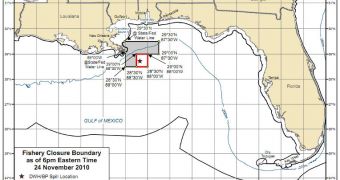Officials at the US National Oceanic and Atmospheric Administration (NOAA) announced yesterday that they decided to close off a surface covering some 4,213 miles in the Gulf of Mexico for royal red shrimping. The decision comes after an incident involving a fishing boat.
A commercial fishing boat which was operating in the area found tar balls in its shrimp nets, and immediately notified authorities. NOAA reacted promptly, closing the aforementioned surface in federally-controlled waters.
The affected area is located off the coasts of Louisiana, Alabama and Mississippi, and only red royal shrimping is forbidden at the location. Other marine species can still be harvested.
Discovering tar balls at the location is nothing but bad news, as it means the ocean floor is contaminated with oil derivatives. Shrimps of this type are caught by pulling nets across the bottom of the deep ocean.
The closure does not affect surface waters in the region because analysis of the fish and water quality in the area did not reveal any signs of tar balls or other forms of contamination, the NOAA team explains.
According to workers on the fishing boat that found the tar balls in its nets, they had earlier in the day trawled for brown shrimp in shallow waters at other locations in the area, but found no oil derivatives.
NOAA decided to close off the federal waters in association with the US Food and Drug Administration (FDA), while the US Coast Guard is working on analyzing the chemicals in the tar balls.
The goal of this study is to determine whether the stuff comes from the Deepwater Horizon/BP spill that was triggered in the Gulf of Mexico on April 20.
The federal agency says that the closure entered effect at 6 pm EST (2300 GMT) on November 24, and added that it does not apply to any state waters in the region.
“We are taking this situation seriously. This fishery is the only trawl fishery that operates at the deep depths where the tar balls were found and we have not received reports of any other gear or fishery interactions with tar balls.” explains Roy Crabtree.
“Our primary concerns are public safety and ensuring the integrity of the Gulf’s seafood supply,” adds the expert, who is the assistant administrator of the southeast region at the NOAA Fisheries Service.
“Royal red shrimp are caught in Gulf waters deeper than 600 feet and are the only species targeted with trawls at these depths,” NOAA officials say in a press release.
“The more common Gulf shrimp species are brown, white and pink shrimp and are caught in waters less than 300 feet deep,” they go on to say.
“The agency has received no reports of tar balls from fishermen that target other species in that area. Fishing for other shellfish and finfish species within this area is still allowed,” the document concludes.

 14 DAY TRIAL //
14 DAY TRIAL //